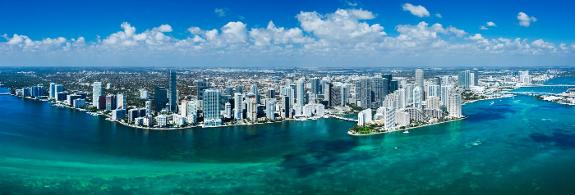Miami vibe
Experience the vibrant Hispanic capital of the Americas
sur in english
Viernes, 23 de febrero 2018, 10:13
As I walk out of the private lift, my eyes take a moment to adjust to the bright light. The polished marble floors and immaculate white walls seem to intensify the brilliant Miami sunshine that floods in through the three-and-half-metre-high floor-to-ceiling windows. I'm being a little cheeky, having a tour of an elite corner penthouse in 'Rise', one of the sparkling new condominium towers in Brickell City Centre. It is an upscale commercial and residential development that's an example of Miami's revived and booming economy. I'm not a potential property investor, but the temptation to see how the other half can live was irresistible.
The wraparound terrace balconies were breathtaking, especially when catching a downward glimpse of the beautifully landscaped pool deck with tropical gardens, some 40 floors below. I began to fall in love with the promise of this luxury lifestyle; yet these exclusive residences are not particularly aimed at European holidaymakers. Instead they are being snapped up by wealthy buyers from South America.
Nexus of the Americas
The real estate agent explained some of the buyers' varied motivations -investments to protect against domestic currency devaluation; a sophisticated base while visiting business interests in the city; or an additional home in Miami for parents of students studying in the States.
Miami has become the global meeting place for the movers and shakers of South America, but not just business people and professionals but artists from all disciplines too, including of course music and acting. This is a trend that has built upon the city's established connections with the Spanish-speaking world, and one that has made Miami a culturally rich and compelling US city destination.
Miami is the nexus of North and South America; not only a commercial hub, but a place of cultural exchange too. In 2002 Miami hosted the Art Basel Festival Miami Beach, giving this world-leading contemporary art fair a perspective from the Americas. Art Basel Miami has since become a regular fixture in the city's cultural calendar. In addition to the art in the main exhibition hall, Collins Park and Soundscape Park become open air galleries for large-scale artworks, performances, and film-showings. Over the past decade and a half, the city has continued to bolster its cultural credentials, making it a destination that is so much more than just beaches. World-class galleries and festivals complement neighbourhood arts centres and events.
Like a local
Discover the districts of Miami and you will be embraced by art, music and food from across the Americas. Little Havana is amongst the best known, a hub of Cuban art galleries, salsa clubs, street cafés, and the Walk of Fame on Calle Ocho, paying tribute to Latin cultural figures. Little Haiti (Lemon City) is well-worth discovering too; it's the district for Afro-Caribbean culture and flavours.
Wynwood, once known as El Barrio, was settled by Puerto Rican immigrants. It has evolved into a centre for art with both established and pop-up galleries; and is renowned for its Wynwood Walls street art park. The post-industrial city block on NW 2nd Avenue between 25th and 26th Streets is an ever-changing canvas for graffiti artists - with many new works emerging to coincide with the Art Basel Miami festival in December.
Although Wynwood, like many of Miami's neighbourhoods has undergone significant redevelopment, you can still find its Puerto Rican flavour in family-run cafeterias and restaurants where you can eat authentic homemade alcapurrias fritters and other specialities.
Without walls
Miami has had a strong Hispanic influence since the era of the Cuban revolution, and now the city has emerged as a thriving international business and cultural hub for ambitious people, many from the Spanish-speaking world, who see Miami as a 'capital' of Latin America.
After the Cuban revolution in 1959, thousands of children were sent to the United States from the island under Operation Pedro Pan. In the 1960s the US-sponsored 'Freedom Flights' led to the resettling of hundreds of thousands of additional Cuban refugees in the US, changing the demographics of Miami forever, and beginning its transformation into what is now a growing metropolis where more than 70 per cent of residents are Hispanic. Many have origins from across the Caribbean and South America, including Cuba, the Dominican Republic, Puerto Rico, Colombia, Venezuela, Argentina and central American countries.
For me, this makes Miami special. It is a captivating mix of the American continents. There is the striking all-American architecture, from Art Deco to glistening skyscrapers; the Caribbean-style beaches lined with swaying palms; and the day-to-day life of the city that conveys an undeniable Latin vibe. Music from the Americas is everywhere for example; reggaetón, merengue and salsa spill out from bars and passing cars, sounds that are now part of mainstream popular culture.
Miami bites
Miami's transition from a relatively small South Florida city to a multicultural, predominantly Hispanic metropolis has not been without controversy and issues. Yet as a visitor to 21st century Miami is to experience a city that pulsates with energy, enthusiasm, art and great food!
Enjoying bites from local hole-in-the wall eateries, and family-cafeterias are often the best travel memories. There are few better ways to immerse yourself in a destination than through eating local food, and in Miami that means immersing yourself in the Americas. The Cubanos, Puertorriqueños, Dominicanos, Colombianos, Venezolanos and Peruvianos brought more than just their language, music and art to Miami - they brought their family recipes too. A day in the Magic City might include an all-American breakfast; lunch with the zest and spice of the finest, fresh Peruvian ceviche; sunset cocktails of an authentic Cuban mojito or tropical daiquiri; and dinner at a salsa club.
That's the diversity of Miami. It's so compelling you might be tempted to make it home too - but if you're thinking of acquiring a sleek corner penthouse, well, you'll need a cool four million US dollars.
